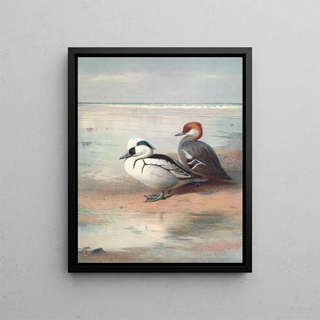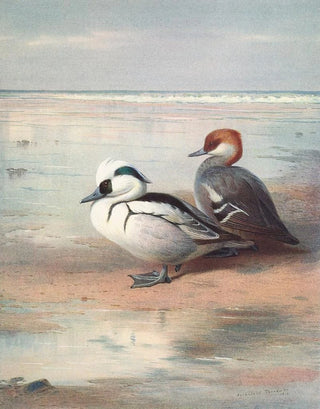Art print | Smew - Archibald Thorburn


View from behind

Frame (optional)
Reproduction Smew - Archibald Thorburn – Engaging introduction
In the captivating world of wildlife art, the artwork "Smew" by Archibald Thorburn stands out for its delicacy and striking realism. This painting, which captures the elegance and grace of this diving duck, invites the viewer to immerse themselves in a world where nature is depicted with almost photographic precision. Thorburn, a true master of his craft, manages to immortalize the fleeting moment of a scene from wildlife, offering a window into the raw beauty of fauna. The art print Smew - Archibald Thorburn allows you to appreciate this iconic piece, while evoking a sense of serenity and admiration for nature.
Style and uniqueness of the work
Archibald Thorburn's style is characterized by meticulous attention to detail and a subtly nuanced color palette. In "Smew," each feather of the duck is rendered with remarkable precision, revealing the play of light and reflections that animate the bird's plumage. The composition of the piece is carefully balanced, highlighting the duck within its natural environment. Elements of nature, such as shimmering water and surrounding foliage, are painted with such finesse that they seem almost tangible. This ability to fuse the animal with its habitat demonstrates a deep understanding of the ecosystem, making Thorburn a pioneer in wildlife representation.
The artist and his influence
Archibald Thorburn, born in 1860, is often regarded as one of the greatest wildlife artists of his time. His work was greatly influenced by his love for nature and his desire to capture wildlife in all its splendor. By studying animal behaviors and habitats, Thorburn developed a unique style that combines realism and poetry. His works have not only contributed to the appreciation of fauna but have also raised public awareness about the importance of conservation. Through his representations, he conveyed a powerful message about the fragility of nature, encouraging future generations to protect our environment. The impact of his work is still felt today, inspiring many artists and naturalists to

Matte finish

View from behind

Frame (optional)
Reproduction Smew - Archibald Thorburn – Engaging introduction
In the captivating world of wildlife art, the artwork "Smew" by Archibald Thorburn stands out for its delicacy and striking realism. This painting, which captures the elegance and grace of this diving duck, invites the viewer to immerse themselves in a world where nature is depicted with almost photographic precision. Thorburn, a true master of his craft, manages to immortalize the fleeting moment of a scene from wildlife, offering a window into the raw beauty of fauna. The art print Smew - Archibald Thorburn allows you to appreciate this iconic piece, while evoking a sense of serenity and admiration for nature.
Style and uniqueness of the work
Archibald Thorburn's style is characterized by meticulous attention to detail and a subtly nuanced color palette. In "Smew," each feather of the duck is rendered with remarkable precision, revealing the play of light and reflections that animate the bird's plumage. The composition of the piece is carefully balanced, highlighting the duck within its natural environment. Elements of nature, such as shimmering water and surrounding foliage, are painted with such finesse that they seem almost tangible. This ability to fuse the animal with its habitat demonstrates a deep understanding of the ecosystem, making Thorburn a pioneer in wildlife representation.
The artist and his influence
Archibald Thorburn, born in 1860, is often regarded as one of the greatest wildlife artists of his time. His work was greatly influenced by his love for nature and his desire to capture wildlife in all its splendor. By studying animal behaviors and habitats, Thorburn developed a unique style that combines realism and poetry. His works have not only contributed to the appreciation of fauna but have also raised public awareness about the importance of conservation. Through his representations, he conveyed a powerful message about the fragility of nature, encouraging future generations to protect our environment. The impact of his work is still felt today, inspiring many artists and naturalists to






